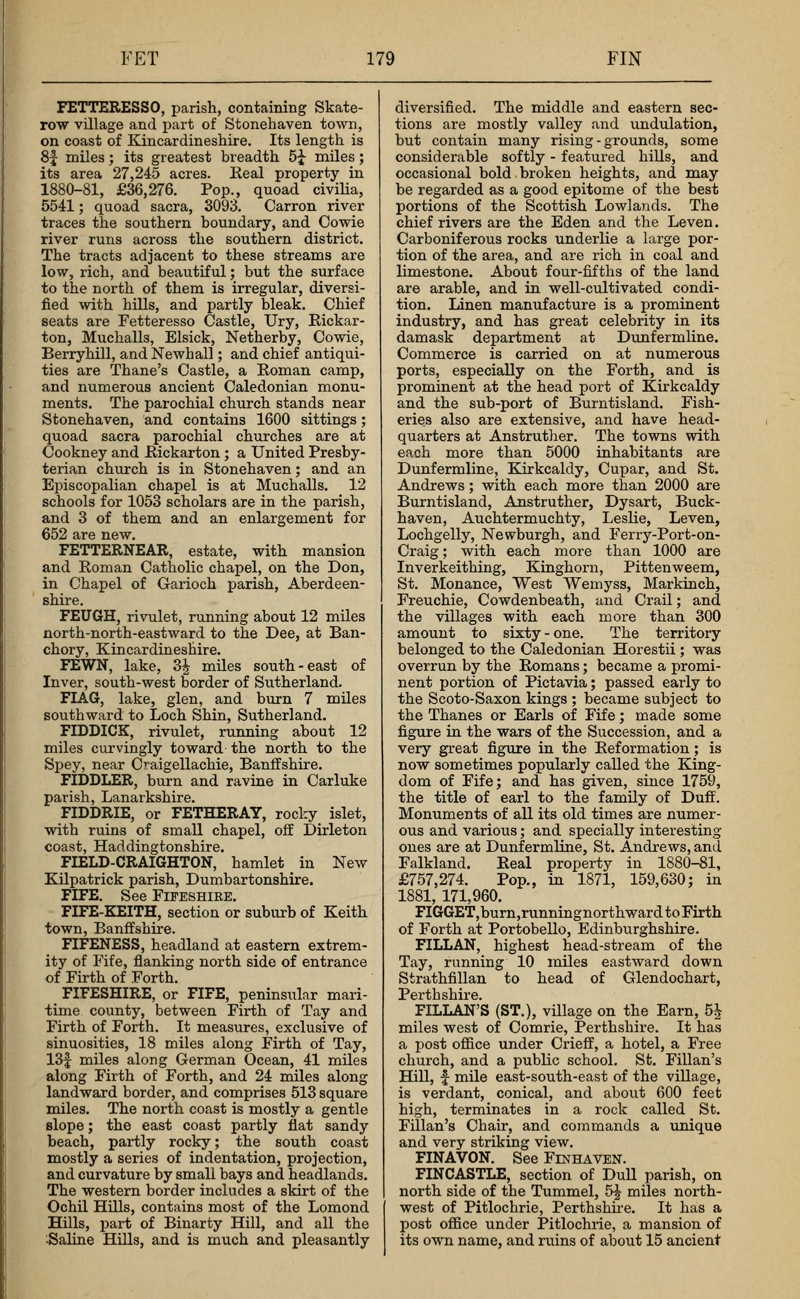FETTERESSO, parish, containing Skaterow village and part of Stonehaven town, on coast of Kincardineshire. Its length, is 8f miles ; its greatest breadth 5J miles ; its area 27,245 acres. Real property in 1880-81, 36,276. Pop., quoad civilia, 5541 ; quoad sacra, 3093. Carron river traces the southern boundary, and Cowie river runs across the southern district. The tracts adjacent to these streams are low, rich, and beautiful ; but the surface to the north of them is irregular, diversified with hiUs, and partly bleak. Chief seats are Fetteresso Castle, Ury, Rickar-ton, Muchalls, Elsick, Netherby, Cowie, Berryhill, and Newhall ; and chief antiquities are Thane's Castle, a Roman camp, and numerous ancient Caledonian monuments. The parochial church stands near Stonehaven, and contains 1600 sittings ; quoad sacra parochial churches are at Cockney and Rickarton ; a United Presbyterian church is in Stonehaven ; and an Episcopalian chapel is at Muchalls. 12 schools for 1053 scholars are in the parish, and 3 of them and an enlargement for 652 are new.
FETTERNEAR, estate, with mansion and Roman Catholic chapel, on the Don, in Chapel of Garioch parish, Aberdeenshire.
FEUGH, rivulet, running about 12 miles north-north-eastward to the Dee, at Banchory, Kincardineshire.
FEWN, lake, 3J miles south-east of Inver, south-west border of Sxttherland.
FIAG, lake, glen, and burn 7 miles southward to Loch Shin, Sutherland.
FIDDICK, rivulet, running about 12 miles curvingly toward the north to the Spey, near Craigellachie, Banffshire.
FIDDLER, burn and ravine in Carluke parish, Lanarkshire.
FIDDRIE, rocky islet, with ruins of small chapel, off Dirleton coast, Haddingtonshire.
FIELD-CRAIGHTON, hamlet in New Kilpatrick parish, Dumbartonshire.
FIFE.
FIFE-KEITH, section or suburb of Keith town, Banffshire.
FIFENESS, headland at eastern extremity of Fife, flanking north side of entrance of Firth of Forth.
FIFESHIRE, peninsular maritime county, between Firth of Tay and Firth of Forth. It measures, exclusive of sinuosities, 18 miles along Firth of Tay, 13f miles along German Ocean, 41 miles along Firth of Forth, and 24 miles along landward border, and comprises 513 square miles. The north coast is mostly a gentle slope; the east coast partly flat sandy beach, partly rocky ; the south coast mostly a series of indentation, projection, and curvature by small bays and headlands. The western border includes a skirt of the Ochil Hills, contains most of the Lomond Hills, part of Binarty Hill, and all the Saline Hills, and is much and pleasantly diversified. The middle and eastern sections are mostly valley and undulation, but contain many rising-grounds, some considerable softly-featured hills, and occasional bold broken heights, and may be regarded as a good epitome of the best portions of the Scottish Lowlands. The chief rivers are the Eden and the Leven. Carboniferous rocks underlie a large portion of the area, and are rich in coal and limestone. About four-fifths of the land are arable, and in well-cultivated condition. Linen manufacture is a prominent industry, and has great celebrity in its damask department at Dunfermline. Commerce is carried on at numerous ports, especially on the Forth, and is prominent at the head port of Kirkcaldy and the sub-port of Burntisland. Fisheries also are extensive, and have head-quarters at Anstruther. The towns with each more than 5000 inhabitants are Dunfermline, Kirkcaldy, Cupar, and St. Andrews ; with each more than 2000 are Burntisland, Anstruther, Dysart, Buckhaven, Auchtermuchty, Leslie, Leven, Lochgelly, Newburgh, and Ferry-Port-on-Craig; with each more than 1000 are Inverkeithing, Kinghorn, Pittenweem, St. Monance, "West Wemyss, Markinch, Freuchie, Cowdenbeath, and Crail ; and the villages with each more than 300 amount to sixty-one. The territory belonged to the Caledonian Horestii ; was overrun by the Romans ; became a prominent portion of Pictavia ; passed early to the Scoto-Saxon kings ; became subject to the Thanes or Earls of Fife ; made some figure in the wars of the Succession, and a very great figure in the Reformation ; is now sometimes popularly called the Kingdom of Fife; and has given, since 1759, the title of earl to the family of Duff. Monuments of all its old times are numerous and various ; and specially interesting ones are at Dunfermline, St. Andrews, and Falkland. Real property in 1880-81, 757,274. Pop., in 1871, 159,630; in 1881, 171,960.
FIGGET,burn,runningnorthward to Firth of Forth at Portobello, Edinburghshire.
FILLAN, highest head-stream of the Tay, running 10 miles eastward down Strathfillan to head of Glendochart, Perthshire.
FILLAN'S (ST.), village on the Earn, 5 miles west of Comrie, Perthshire. It has a post office under Crieff, a hotel, a Free church, and a public school. St. Fillan's Hill, | mile east-south-east of the village, is verdant, conical, and about 600 feet high, terminates in a rock called St. Fillan's Chair, and commands a unique and very striking view.
FINAVON.
FINCASTLE, section of Dull parish, on north side of the Tummel, 5 miles north-west of Pitlochrie, Perthshire. It has a post office under Pitlochrie, a mansion of its own name, and ruins of about 15 ancient castles, and it gives the title of viscount to the Earl of Dunmore.

